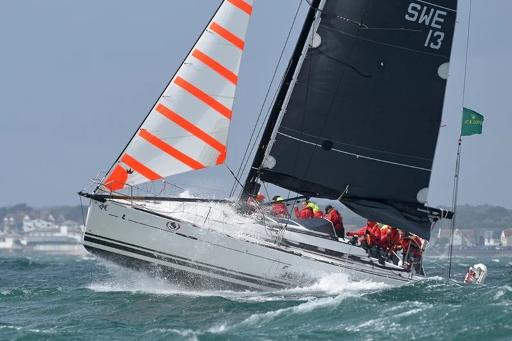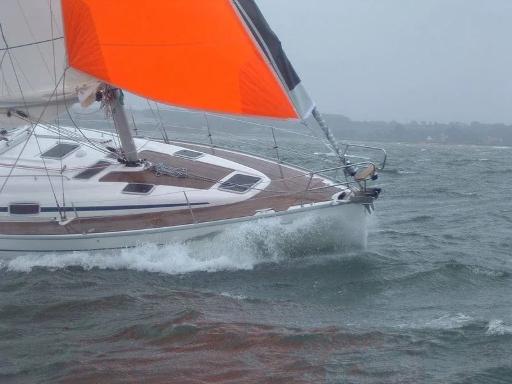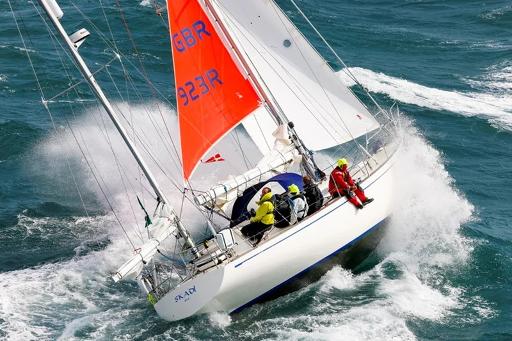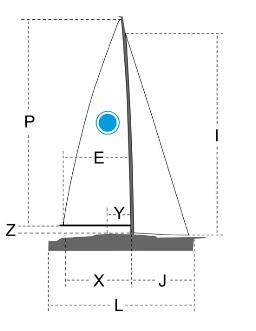A good set of storm sails can be a get out of jail free card if you find yourself caught in heavy weather. A necessity for offshore passages whether cruising or racing and a prudent safety item for most cruisers.
What are storm sails?
A typical set consists of two heavy duty sails built from a durable woven fabric such as Dacron: a storm jib and a main trysail. These are often brightly coloured to aid visibility which could be crucial in a search and rescue (SAR) situation.
Storm Jib

©RORC/Rick Tomlinson
A storm jib is the smallest jib carried on board and is often separate to the normal sail inventory although some boats will choose to have a number 4 jib which meets the requirements of a storm jib.
A storm jib should be hoisted on a suitable headstay, ideally aft of the primary forestay. This brings the centre of effort aft, towards the middle of the boat, which helps maintain balance on the helm.
Some storm jibs include a structural luff rope or wire so do not need to be attached to an existing stay.
Where an inner stay is not possible, a storm jib can be hoisted on the primary forestay. The attachment method should be independent of any head foil / luff groove used. For example, if the normal jibs are hoisted in a TuffLuff or Harken foil, the storm jibs should feature soft hanks large enough to pass around the forestay with or without the foil.
Yachts with hank-on sails can simply use standard hanks to attach the storm jib in the same manner as the standard jibs / genoa.
For cruising boats with roller furling headsails, an option is available to hoist a storm jib over the furled genoa with an extra sleeve. A Dacron sleeve is passed around the furled sail with the storm jib attached on the aft edge.

image©Oleu Watersports GmbH
A storm jib is typically high clewed and can either be sheeted via the same lead as the genoa or using an additional outboard lead located at the rail.
Storm Trysail

Picture2Image Copyright: Carlo Borlenghi/ROLEX
A storm trysail (or tri-sail) replaces the mainsail in extreme or heavy weather conditions where the fully reefed main still presents too much sail area. Some owners will opt for a mainsail with a deep 3rd reef making it easier to reduce/increase sail area in changing conditions. However, even a deeply reefed main cannot replace a tri-sail in the most extreme conditions.
A trysail is also hoisted up the mast but must be independent of the mainsail. For boats with slugs / cars on the main, one of the most popular options is to install a secondary mast track running parallel to the primary track or groove so that the trysail can be hoisted without removing any of the cars / slugs of the main. For luff rope main systems, the trysail can be hoisted in the same luff groove. Other methods exist, including simple Velcro straps to attach the tri-sail to the mast.
A storm trysail does not attach to the boom but instead sheets directly to an aft block.
Storm Sail Sizing

Image Copyright- World Sailing©World Sailing
World Sailing Offshore Special Regulations (OSR) governs the rules for boats taking part in recognised offshore races, including the storm sails they must carry. While there is no such rule for cruising boats, the information provided in the OSR is based on best practice and is updated at least every 2 years to reflect the latest knowledge in offshore safety including learnings from incidents at sea.
OSR 4.27 Storm & Heavy Weather Sail Specifications includes the requirement for ‘highly-visible’ colours and the ability to hoist a jib ‘independent of a luff groove’. The maximum sail areas are also stipulated as follows which can be a useful guide for non-racers:
Storm jib
- Area of 13.5% height of the foretriangle squared
- For Cat 2 races this reduces to area of 5% height of the foretriangle squared with a maximum luff length of 65% of height of foretriangle
For example a typical 35ft Yacht with 14m foretriangle height: Max. storm jib area = (5/100)*196 = 9.8m2
Storm trysail
- Area not greater than 17.5% mainsail hoist (P) x mainsail foot length (E)
- For sails made after 2011: The storm trysail area calculated as (0.5 x leech length x shortest distance between tack point and leech)
Summary on Storm Sails
Storm sails can be invaluable for surviving heavy weather and for the minimal extra weight / storage space required it is a no-brainer to carry them. The exact rigging setup should be carefully planned to be as simple and robust as possible. Just like all safety equipment, it’s absolutely essential to familiarise yourself with how to set your storm sails, before heading out on a longer passage where they might be needed. The OSR states the rules around storm sails for racers but also provides useful guidance and best practices for cruisers.
If you have any questions about storm sails, please feel free to email us at [email protected], or click the link below to see our full range:


Do you need a set of storm sails?